So did Bach actually write consecutive perfect fifths or octaves in his chorales, breaking the First Commandment of part-writing? The short answer is yes, he certainly did. The long answer, however, will be far more informative if it addresses additional questions regarding consecutive perfect intervals: What kind of consecutives or parallels did Bach write and in what specific contexts? How many consecutives are in parallel motion as opposed to contrary motion? Did he only write parallels that involve non-chord tones (i.e. parallels that disappear with the removal of NCTs)? Conversely, what do the chorales tell us about how Bach prevented parallels? What kinds of parallels did Bach intentionally prevent? These last two questions will be taken up in a later post. For now, let’s concern ourselves with the data relating to the first set of questions.
An interesting paper on this topic has already been written by George Fitsioris and Darrell Conklin who used a computer program to locate parallel fifths in the Riemenschneider edition chorales. It gave me a great head start on the data presented here. However, two problems with the paper limit its scope considerably. First, it deals only with consecutive P5s and P8s in parallel motion, ignoring any consecutives in contrary motion (which are generally considered to be categorically the same, at least in most music theory textbooks). Second, only the chorales found in the Riemenschneider edition were included in the data, thereby excluding nearly 60 chorales. For the research to be more informative and comprehensive, the scope must be broadened.
So how many consecutive P5s/P8s did Bach write in the chorale?
Well, technically, there are at the very least 46 instances of consecutives, which are listed below. The first number is the chorale’s BWV number, with the decimal indicating movement number. The “R” numbers are Riemenschneider edition numbers. And an important note about measure numbers: the Aufgesang measures of all bar form chorales (which constitutes the majority of Bach’s chorales) are counted twice in my research since the Aufgesang is always repeated. Thus, measures within the Aufgesang are numbered as “4/8.” Decimals, when used with measure numbers, refer to beats.
7.7 (RX), measure 2/6.1
22.5 (RX) measure m.27-28
26.6 (R48) measure 4.2
33.6 (R13) measure 14
40.8 (R8) measure 2.2
40.8 (R8) measure 4.2
40.8 (R8) measure 6.2
40.8 (R8) measure 16.2
48.7 (R266) measure 14.2
60.5 (R216) measure 6
78.7 (R297) measure 4-5
86.6 (R4) measure 13-14
92.9 (RX) measure 14
99.6 (RX) measure 11
99.6 (Rx) measure 12
108.6 (R45) measure 4
111.6 (RX) measure 15
115.6 (R38) measure 10-11
146.8, (RX) measure 10.3
157.5, (RX) measure 10.1
167.5 (Rx) measure 11/25-12/26
174.5, (R58) measure 23.4
183.5 (R123) measure 14
190.7 (R327) measure 18
244.40 (R121) measure 4.3
244.44 (R80) measure 14 (2 instances)
244.54 (R74) measure 14 (2 instances)
244.62 (R89) measure 14 (2 instances)
245.40 (R107) measure 23
248.33 (R139) measure 2.2
251 (R329) measure 14.1
263 (R128) measure 6.2
266 (R208) measure 5
301 (R134) measure 3.3
308 (R27) measure 9
323 (R320) measure 8
329 (R212) measure 5
333 (R226) measure 12
340 (R277) measure 21
347 (R2) measure 14
361 (R264) measure 12.2
385 (R36) measure 6
436 (R278) measure 18
Excluding consecutives following a fermata…
As I said, “technically” there are 46 instances of consecutives. However, we can eliminate over half of these (26 to be exact) if we exclude consecutives that occur between the last chord of one phrase and the first chord of the following phrase, as in BWV 244.54 below, their exclusion perhaps being warranted by the fact that new phrases constitute a syntactical restart to a significant degree.
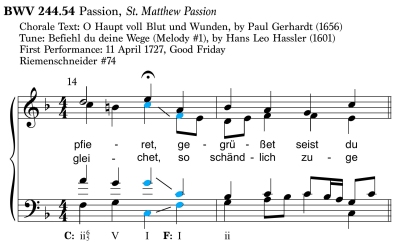
See the Manuscript: Image Link: D-B Mus. ms. Bach P 25
The 26 instances of “fermata consecutives” are:
60.5 (R216) measure 6
78.7 (R297) measure 4-5
92.9 (RX) measure 14
99.6 (Rx) measure 12
108.6 (R45) measure 4
111.6 (RX) measure 15
115.6 (R38) measure 10-11
157.5, (RX) measure 10.1
174.5, (R58) measure 23.4
183.5 (R123) measure 14
190.7 (R327) measure 18
244.44 (R80) measure 14 (2 instances)
244.54 (R74) measure 14 (2 instances)
244.62 (R89) measure 14 (2 instances)
245.40 (R107) measure 23
266 (R208) measure 5
301 (R134) measure 3.3
329 (R212) measure 5
333 (R226) measure 12
340 (R277) measure 21
347 (R2) measure 14
385 (R36) measure 6
436 (R278) measure 18
However, before moving on and completely ignoring these “non-syntactical” consecutives, let’s consider them further, as they are not completely devoid of information. In fact, they may not be entirely non-syntactical after all. First, while 26 sounds like a high number, it’s actually not. If we estimate (conservatively) that there are on average six phrases per chorale (which means five internal cadences), then there are more than 2,000 internal cadences in the ~410 chorales of Bach. Even if we set the number at that low threshold of 2,000, then the 23 cadences represented here constitute only 1.15% of internal cadences feature consecutives between the phrases, a minuscule number. This extremely low figure would seem to suggest that Bach did not completely disregard the voice-leading between phrases as being syntactically insignificant. It should also be pointed out that not all phrase junctures are equal. Some cadences, like those internal within the Aufgesang, are more open-ended than cadences ending the Aufgesang. The more open-ended the cadence, the more syntactically connected with the subsequent phrase. Of the 23 cadences, eight consist of a half cadence followed by a phrase that begins in the same key. The other 15 either consist of a cadence after which a phrase begins in a new key or they end the Aufgesang. 14 of these 15 are authentic cadences. (In one case, a half cadence is followed by a phrase that starts in a new key area.)
[Note: I did not consider cadence transitions between the end of the Aufgesang and the repeat to the beginning of the chorale. Doing so would have almost certainly increased the number of “fermata consecutives,” thereby decreasing the proportion of “fermata consecutives” at open-ended phrases.]
If we put these 26 “fermata consecutives” aside, we’re left with 20 consecutives to deal with. In each case, I have examined original manuscripts to ensure that the consecutives were not the result of a copyist error. (Fitsorios and Conklin found this to be the case with BWV 355 (R169) measure 15. Parallel fifths result from a mistake in the melody – the soprano’s beat 1 B should be an A.) Images and links to original documents are provided. Here are the remaining 20:
7.7 (RX), measure 2/6.1
22.5 (RX) measure m.27-28
26.6 (R48) measure 4.2
33.6 (R13) measure 14
40.8 (R8) measure 2.2
40.8 (R8) measure 4.2
40.8 (R8) measure 6.2
40.8 (R8) measure 16.2
48.7 (R266) measure 14.2
86.6 (R4) measure 13-14
99.6 (RX) measure 11
146.8, (RX) measure 10.3
167.5 (Rx) measure 11/25-12/26
244.40 (R121) measure 4.3
248.33 (R139) measure 2.2
251 (R329) measure 14.1
263 (R128) measure 6.2
308 (R27) measure 9
323 (R320) measure 8
361 (R264) measure 12.2
Cadential Consecutives created by anticipation + delayed seventh…
By far the most common type of mid-phrase consecutive 5ths one finds in the Bach chorales is created by the simultaneous appearance of a Re-Do anticipation in the soprano over a delayed arrival of the seventh of a V7 (Sol-Fa) in an inner voice at an authentic cadence. Nine of the remaining 20 consecutives constitute this very specific figure.
26.6 (R48) measure 4.2
40.8 (R8) measure 2.2
40.8 (R8) measure 4.2
40.8 (R8) measure 6.2
40.8 (R8) measure 16.2
146.8, (RX) measure 10.3
244.40 (R121) measure 4.3
263 (R128) measure 6.2
361 (R264) measure 12.2
The resulting parallel fifths are considered to be “non-structural” since they involve a non-chord tone (NCT) in the soprano combined with a passing figure, the chord seventh. Of the nine instances, four of them appear in a single chorale: BWV 40.8 (R7).
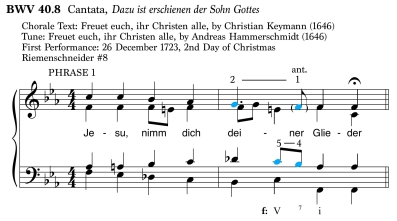
See the Manuscript in Bach’s own hand: Image Link: D-B Mus. ms. Bach P 63
That leaves us with 11 consecutives yet to examine:
7.7 (RX), measure 2/6.1
22.5 (RX) measure m.27-28
33.6 (R13) measure 14
48.7 (R266) measure 14.2
86.6 (R4) measure 13-14
99.6 (RX) measure 11
167.5 (Rx) measure 11/25-12/26
248.33 (R139) measure 2.2
251 (R329) measure 14.1
308 (R27) measure 9
323 (R320) measure 8
Other consecutives created by NCTs…
As mentioned, these nine consecutives are considered non-structural since they involve non-chord tones. Eliminate the non-chord tones and the consecutives disappear, leaving a foundational harmonic framework that features faultless voice-leading. Of the 11 remaining consecutives, four others also result from NCTs. Three involve a passing tone and one involves a neighbor tone. Let’s take these one by one.
BWV 48.7 (R266) measure 14.2
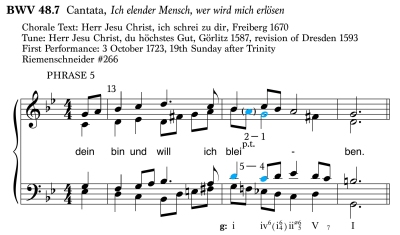
See the Manuscript in Bach’s own hand: Image Link: D-B Mus. ms. Bach P 109
Here, the alto’s passing tone creates parallel fifths with the tenor. In terms of scale-degrees, these parallels resemble the nine examined in the previous section: Re-Do motion over Sol-Fa. In this particular context, the strength of the parallel tenths between bass and alto overrides the negative effect of the parallels (much as parallel tenths between outer voices in a I-V43-I6 progression overrides the effect of the unresolved seventh). Yes, Bach could have left the alto’s passing tone out, thereby eliminating the parallel fifths, but the parallel tenths were perhaps simply too compelling a musical idea. The soprano’s upward movement contrary to the parallels further masks any negative effect.
BWV 167.5 (RX) measure 11/25-12/26

See the Manuscript: Image Link: D-B Mus. ms. Bach P 46, Faszikel 2
This passage represents the only instance of midphrase consecutive octaves that occur in parallel motion. All other instances of consecutive octaves occur in contrary motion, and all other parallel consecutives are parallel fifths. Two observations are worth pointing out in this particular context. First, both voices involved have NCTs. Second, this chorale features an elaborate instrumental accompaniment that is not included in the example. Still, the parallels are curious. The tenor could easily have stayed on the D instead of leaping to the F#. Alternatively, the bass could have gone to D# instead of F# just as the continuo part does (not shown in the example). So baffling are these parallels that I checked the original manuscripts for both the score and the parts. Both show that Bach indeed wrote the parallels. At least I am not alone in my bewilderment. The scholars of the BGA (Bach Gesellschaft Ausgabe) apparently were so puzzled that they decided to insert a question mark by the bass’s F#:
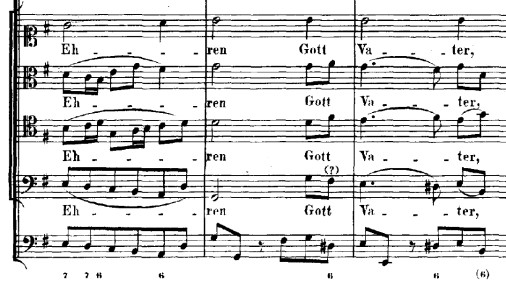
BWV 248.33 (R139), measure 2.2
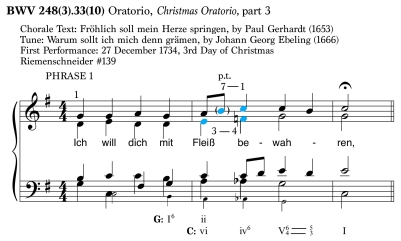
See the Manuscript in Bach’s own hand: Image Link: D-B Mus. ms. Bach P 32
Here, perhaps the bass’s chromatic descent combined with the use of mode mixture sufficiently attenuates the negative effect of parallels. Perhaps the passing tone in the melody had become a standardized feature of the chorale tune. Or perhaps neither of these sufficiently excuse these parallels!
BWV 99.6 (RX), measure 11
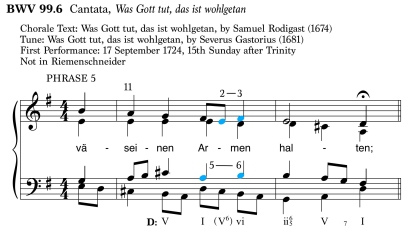
See the Manuscript in Bach’s own hand: Image Link: PL-Kj Mus. ms. Bach P647 [früher D-B Mus. ms. Bach P647]
Another head-scratcher. The parallels are created by a needless neighbor tone. In none of the other six chorale settings of this Gastorius tune did Bach add a lower neighbor in this spot.
These four consecutives (BWVs 48.7, 167.5, 248.33, 99.6) are, like the prior nine examined, created by the insertion of NCTs. The remaining seven consecutives, however, constitute legitimate midphrase chordal consecutives:
7.7 (RX), measure 2/6.1
22.5 (RX) measure m.27-28
33.6 (R13) measure 14
86.6 (R4) measure 13-14
251 (R329) measure 14.1
308 (R27) measure 9
323 (R320) measure 8
The rest, involving chordal consecutives…
BWV 7.7 (RX), measure 2/6
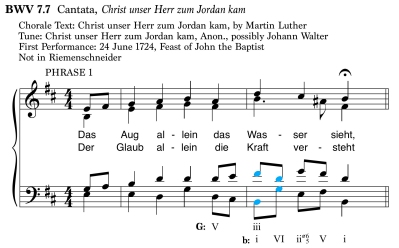
See the Manuscript of the parts: Image Link: D-LEb Thomana 7
These consecutive fifths in contrary motion are also a bit curious since an easy fix presents itself. The tenor could easily move from its F# to G, thereby doubling the root of the VI chord, preparing its G in the iiø65 chord that follows, and, of course, eliminating the consecutives.
BWV 22.5 (RX), measures 27-28
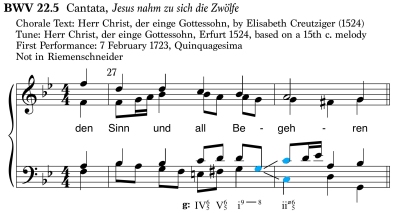
See the Manuscript in Bach’s own hand: Image Link: D-B Mus. ms. Bach P 119
Again, curious. Why have the tenor leave its D before moving to the C? The chordal leap to G is entirely unnecessary since both the bass and the alto have the G and since movement directly to C from the D would constitute strong voice leading. It should be noted that this chorale, too, has a more elaborate instrumental texture. Yet, nothing within that texture would seem to require the tenor’s leap to G from a voice-leading standpoint.
BWV 33.6 (R13), measure 14
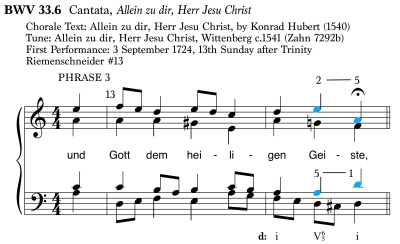
See the Manuscript: Image Link: D-B Mus. ms. Bach 1023
Downward leaps in the chorale melody play a role in four of the remaining six instances of consecutives, including this one. The tenor’s leap up to Do results in a doubled root. But certainly a doubled root is not reason for writing consecutive fifths. We’ve already seen Bach go out of his way to double the chordal fifth in another occasion. So there’s no clear explanation as to why the tenor doesn’t simply remain on the A here. (The beginning of the phrase that follows in no way requires it either.)
BWV 86.6 (R4) measures 13-14 & BWV 251 (R329) measure 14
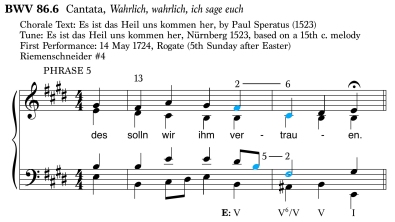
See the Manuscript: Image Link: D-B Mus. ms. Bach P 157
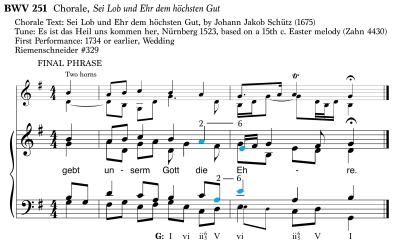
See the Manuscript in Bach’s own hand: Image Link: D-B Mus. ms. Bach P 123
These two instances of consecutives are taken together since they occur in the exact same spot in two settings of the tune “Es ist das Heil uns kommen her.” The melody features a descending leap from Re to La following a scale down from Fa. This descent of a sixth (Fa to La) poses voice-leading challenges. In BWV 86, imagining an easy fix to eliminate these consecutives is difficult. Perhaps the most easily achieved option would be for the tenor to leap down to the F# directly from the D# without the chordal skip to B. In BWV 251, Bach places the alto above the soprano in order to alleviate spacing limitations, something he does in this spot in another setting of the tune (BWV 9.7, R290). Yet, consecutive octaves still occur. The effect of these are attenuated by the voice-crossing and by the soprano’s quick movement away from the E (the only time in Bach’s five settings that the melody features this). If examining only the voice parts, a fix is easily achieved by taking the tenor up to E at the ii65 chord (see below). However, this would result in parallel unisons with the lower horn part.
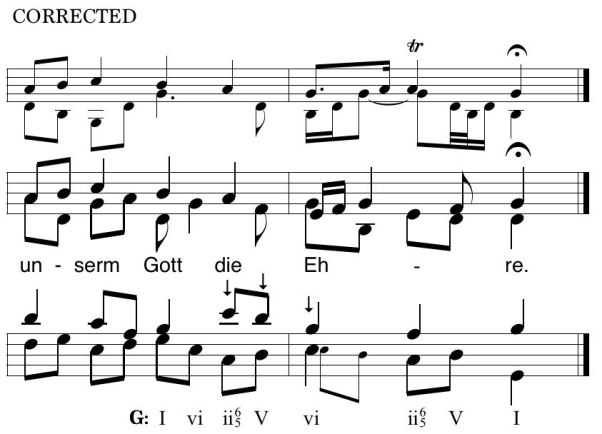
BWV 308 (R27), measure 9
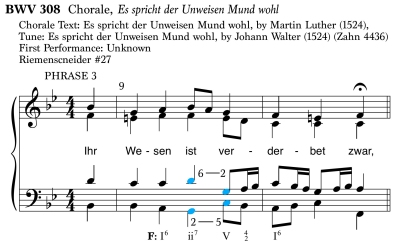
Chorale survives by way of the Breitkopf edition (pub. 1780s): Image
Taking this passage as evidence, consecutives in contrary motion are much less objectionable to consecutives in parallel motion, even if the former involves chordal consecutives and the latter involves consecutives created by NCTs. The tenor here could have moved to C instead of G, thereby creating parallels with the soprano’s passing figure. Yet, Bach opted for the contrary motion consecutives.
BWV 323 (R320), measure 8
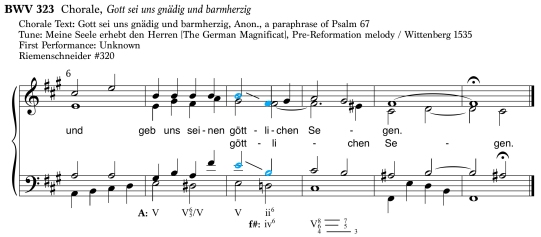
Chorale survives by way of the Breitkopf edition: Image
Another descending soprano leap occurs here, though a simple early arrival of the B as a chordal skip in the tenor would stagger the fifths sufficiently, a simple “fix” that Bach employs frequently.
Quick Summary of the data
While Bach certainly did write consecutive fifths and octaves in the chorales, we see patterns emerge in the kinds of consecutives that appear and in the contexts in which they occur.
Consecutive fifths are far less objectionable than consecutive octaves. Of the 46 consecutives, only 10 involve octaves. If we eliminate “fermata consecutives,” only 3 of 20 involve octaves. Considering only chordal consecutives, 2 of 7 involve octaves.
Consecutives involving NCTs are less objectionable than chordal consecutives. Of 20 consecutives not occurring after a fermata, 13 involve NCTs.
Consecutives in contrary motion are far less objectionable than consecutives in parallel motion. Of all the 33 consecutives that involve leaping voices, only six are in parallel motion. Even with “fermata consecutives,” only four of 26 involve parallel motion.
Consecutives involving inner voices are far less objectionable than soprano-bass consecutives. Not a single one of the non-fermata consecutives occur between soprano and bass. This may partly be due to the fact that chorale melodies feature far more conjunct motion than disjunct. Since Bach considers contrary motion consecutives to be less objectionable than parallels, and since contrary motion consecutives virtually always involve leaps, the lack of soprano-bass consecutives is perhaps understandable. Nontheless, chorale melodies do feature occasional leaps, so the complete lack of outer voice consecutives remains significant. Of the 26 fermata consecutives, only six involve outer voices.
Parallel fifths created at authentic cadences involving a RE-DO anticipation in the melody over SOL-FA movement adding the seventh of a V7 are not at all objectionable. Nine of the 13 consecutives created by NCTs represent this specific parallel motion. For the record, he writes them in both major and minor modes – five are in major, four in minor.
Bach does not write stepwise chordal parallels. There simply are none. All stepwise parallels involve NCTs rather than being chordal consecutives. All chordal parallels (there are only 2, and both are fifths) involve leaps.
The question of why Bach wrote the consecutives that he did, particularly those chordal ones that are quite fixable, is difficult to answer. Malcolm Boyd has suggested that Bach, who often quickly tossed off his cantata-ending chorales at the end of the week prior to Sunday services in Leipzig, simply overlooked these consecutives. They are truly mistakes. Fitsioris and Conklin, on the other hand, challenge this idea. (“After detailed research, carefully avoiding ‘wrong’ scores found in certain printed editions of Bach chorales, we came up to the conclusion that in 18 passages Bach seemed to be tolerant with such ‘forbidden’ successions.” p.2) If Boyd is right, then this research tells us something about the kinds of consecutives that evaded the great composer’s ear and eye. (Honestly hard to imagine.) If Fitioris and Conklin are right, this research tells us about the kinds of consecutives he considered allowable. Of course, both could be right to some degree, with some consecutives being intentionally allowed (an idea which seems to be supported by the patterns we’ve seen) and others being mistakes. Perhaps we can learn more by looking at the kinds of parallels Bach intentionally prevented via suspensions, chordal leaps, NCTs, voice-crossings, and other devices. Does he in some cases prevent the same kinds of parallels that have been observed here? If so, might this lend support to the idea that these consecutives are indeed mistakes? This will be the topic of a subsequent post.

Pingback: “Correcting” Bach’s Parallel Fifths: Breitkopf Editorial Practices | For M is Musick
Hi, I just commented on your post titled “How Bach Prevented Consecutive Fifths and Octaves”. The work you’ve done in this article is as good as your subsequent post. Unfortunately, examples: BWV 48.7 (R266) measure 14.2, BWV 248.33 (R139), measure 2.2, and BWV 99.6 (RX), measure 11, are invalid for the same reason as examples 17 and 18 in the subsequent article, they are not actual instances of consecutive/parallel P5’s. Divisions of the beat given by the meter cannot be considered traditionally when evaluating the integrity of counterpoint. In other words, “passing parallels P5s” should only be scrutinized in certain cases, but not these. Enjoyed the other examples greatly and will continue to reference them.
Thanks for the comment. Your comment about submetrical parallels is rather curious. Certainly structural consecutives are more problematic (speaking generally) than consecutives involving notes of figuration, as might be reflected in the proportion of the latter found in the Bach chorales relative to the former. Still, consecutives created by notes of figuration (e.g. passing or neighbor tones) are still considered problematic and to be avoided in both strict counterpoint and free counterpoint. In what sense do you mean that these examples are “invalid”? Invalidating these examples (in whatever sense you mean) would defeat one of the main goals of these posts, namely, exploring the precise contexts in which Bach allowed himself to write (or in which Bach simply overlooked) non-structural parallels. While I do believe that the “cadential” parallels I discuss were in no way considered objectionable to Bach, I think it should also be pointed out that if mid-phrase non-structural parallels involving passing or neighbor tones were entirely “valid,” we would see many more than we do in the more than 5400 measures of part writing in the four-part chorales.